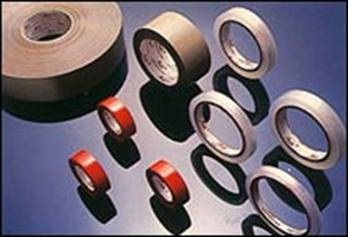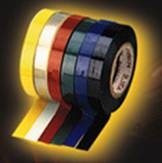 Prithviraj S.
Eshore
Prithviraj S.
EshoreProduct
Market - PVC Insulation Tapes - A
Comprehensive Analysis
Report Prepared by -
 Prithviraj S.
Eshore
Prithviraj S.
Eshore
Amit
Tandon
Payal
Yadav
Rahul Singh
Rajiv
Vidyarthy
Harsh
Shah
Siddharth
Dahiya
Siddhartha
Butalia
Product
 PVC Electrical Insulation
Tapes
PVC Electrical Insulation
Tapes
Product specs (general)
–
Lengths : 8 - 25 meters
– Widths : 1.25 cm, 1.90cm & 2.50 cm
– Colours : Black, Yellow, Red, Blue and Green
(Used for distinction in phase wiring)
Category players
Magic, Miracle,
Steelgrip, Wonder,
•
Prices
–
High (Above
Rs.7, till roughly Rs.10)
–
Medium
(Rs.5 – Rs.7 per tape)
–
Low
(Below Rs.5 per tape)
–
Stickiness
of tape
–
Good
‘stitching’
–
Adhesive
should not spread due to heat
–
Long
lasting adhesion
–
Water,
weather and temperature resistant.
–
Also
resistant to acids, alkalis, oils, greases etc.
porter’s Five
Forces Analysis
Threat of intense segment rivalry
The adhesive tape
industry
consists of the major players Pidilite (acquired Bhor Industries), Morgan, Sanghi, Paramount, Chetana Polypack,
Fourpillar Corporation, Asia Chemicals and Tesa. The product
types are
used for packaging, insulation, mounting, protection, medical,
stationery or
cellotapes). All-India market size is Rs. 600 Crores and is growing at
10% p.a.
Insulation tapes have a market size of Rs. 40 Crores (approx.). These are made of PVC, Polyester, Teflon, Kapton etc. The major brands in the PVC insulation tapes segment are Magic, Miracle, Steelgrip, Anchor, Wonder and Deer.
Including the
unorganized sector,
there are around 200 players in the market (even though most are
regional). The
industry is experiencing decreased margins on production and faces the
threat
of cheap imports (especially from
Threat of New Entrants
Entry and exit
barriers do exist,
but essentially curtail the larger players . Among the smaller players,
firms
frequently enter and leave the market and thus returns are stable and
low. A multi-brand
market exists, with distinct rungs differentiable by price and quality.
On the
whole, the market exhibits the qualities of an oligopoly. There are a
large number of buyers
and sellers with distinct market leaders. Most retailers stock
select
multiple brands but tend to push specific preferred brands (based
usually on
their margins on different brands).
Future
entry
Threat of Substitute product
There
is no distinct brand preference. The brand is rarely demanded at
time of purchase, as the consumer typically asks for ‘PVC tape’ or
‘electric
tape’. The threat of substitutability exists in the generic category
from
packaging and cellotapes for household use. However, as final household
consumption is minimal and most use is by electricians and
auto-mechanics, this
may be ignored. Within the specific segment,
threat of buyer’s growing
bargaining
The main differentiator in the
PVC electrical insulation tapes market is the buyers and their
consumption
patterns. Thus, it is imperative that a comprehensive analysis be done
of the
consumer. Buyer’s may be divided into the various segments based on
their use.
PVC insulation tape is
With
respect to non-industrial buyers, which
are the prime focus of competition, the product may be sold to the
retailers
and then onward through seller-push or to the end consumer (the
electricians,
auto mechanics etc.) in an attempt to generate demand pull. Due to
their
significance in their market, these are
threat of supplier’s growing
bargaining
The
raw materials require in the manufacturing process are PVC Films,
Synthetic Rubber, Antioxidants, Plastic Resins, Paper Core, Primers,
Master
Batches etc. Supplier’s bargaining power does not form a significant
threat as
suppliers are not in a position to leverage their status and raise
prices or
reduce quantity supplied. Supply of the inputs is essentially in the
open
market and specific parameters for supply to this industry are
negligible, thus
reducing supplier differentiation and negotiating power. Moreover, the
suppliers are not of a colluding nature, and the cost of switching
suppliers is
not significantly high.
The
players in the
Appendix A
Retailer Push – Significant due to low consumer involvement
Overview
•
Distribution
setup –
–
Open
Market (Region centric wholesalers)
–
Salesmen
from company distributors
•
Large
company distributors supply the product along with other products of
the
company
•
Wide
difference in price and margins across retailers though relative
hierarchy of
the same is maintained
•
Retail
brands stocked vary across areas depending on
–
Company
distribution width and depth
–
Retailer
choice of stocked items
Retailer
Incentives
•
The
existence of a retailer push market necessitates stock inventory
incentives
–
Margin
price varies across brands
–
Company
distributors with multiple products can leverage their position
–
Credit
on sales (known to be given up to 45 days)
Retailer
Awareness
–
High
among top rung (Steelgrip, Anchor, Magic)
–
Prompted
among others (Wonder, Kona, Deer etc.)
–
Within
second rung, awareness restricted to stocked brands
Appendix B
Demand Pull –
Overview
•
Quality
perceptions vary and are not primary parameters in the purchase decision
•
Low involvement
product.
•
No distinct brand
leader.
•
Huge scope for positioning in
consumers mind.
•
Consumers
tend to stick within price bands depending on price sensitivity as
higher
priced brands have perceived higher quality
Consumer
Awareness
–
Restricted
to most frequently used brands
–
Usually
coincides with top rung brands
Target
Audience
Demographics
Ø
Age: 20-45 years
Ø
Region:
Ø
Occupation:
Electricians, Auto Mechanics
Ø
Sex: Male
Ø
Religion:
Insignificant
Ø
SEC: D, C
Ø
Family life cycle:
Young, single/married.
Psychographics
•
Raju hails from a
village near
•
Works everyday and
has a hectic and physically exhausting job.
•
Recognizes that he
fulfils a need requiring skill and
expertise
•
He is glad to do so
and make a living out of it.
•
Has invested many
years perfecting his skills
•
His ‘chacha’ took him
in when he came to
•
Operates primarily in
a specific area
•
Known by his regular
customers who also generate business through
word-of-mouth.
•
He has recently been
thinking of purchasing a mobile phone to make
himself more accessible
Product related
behavioural patterns
•
Occasions: Regular user
•
User status: Repeat user
•
Loyalty status: None
•
Readiness Stage: Informed
•
Attitude toward product: High use, low involvement
 www.foolonahill.com
www.foolonahill.com